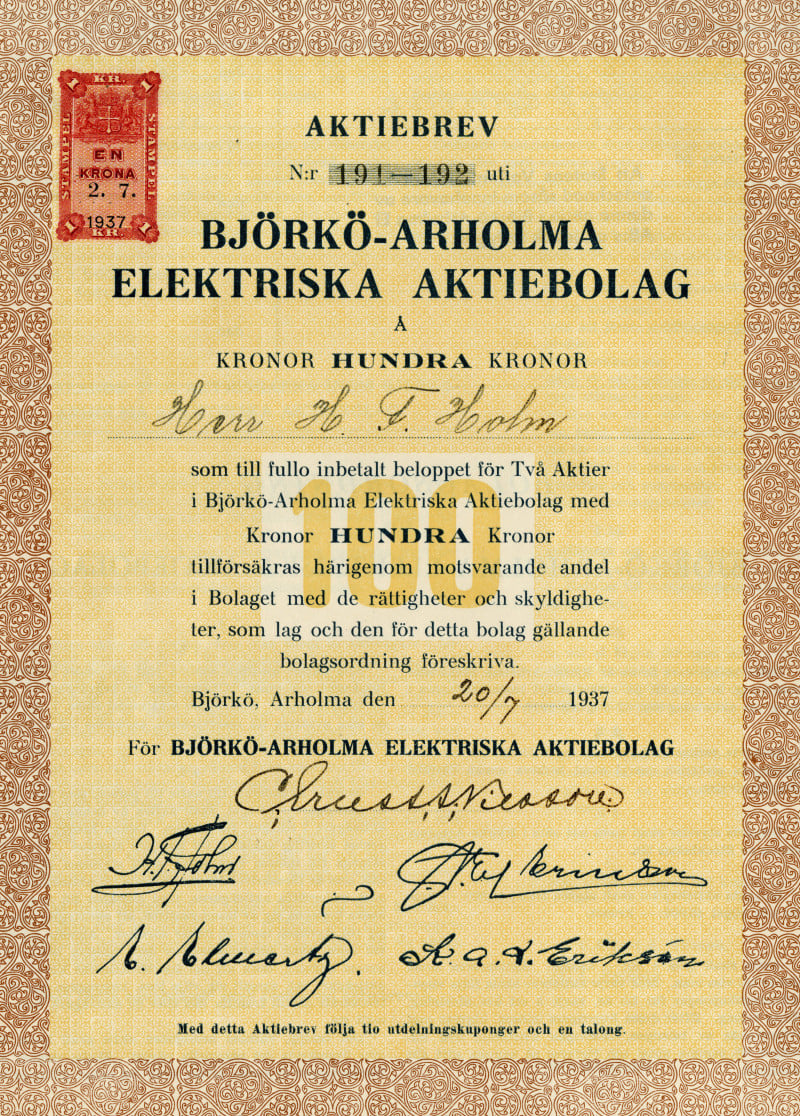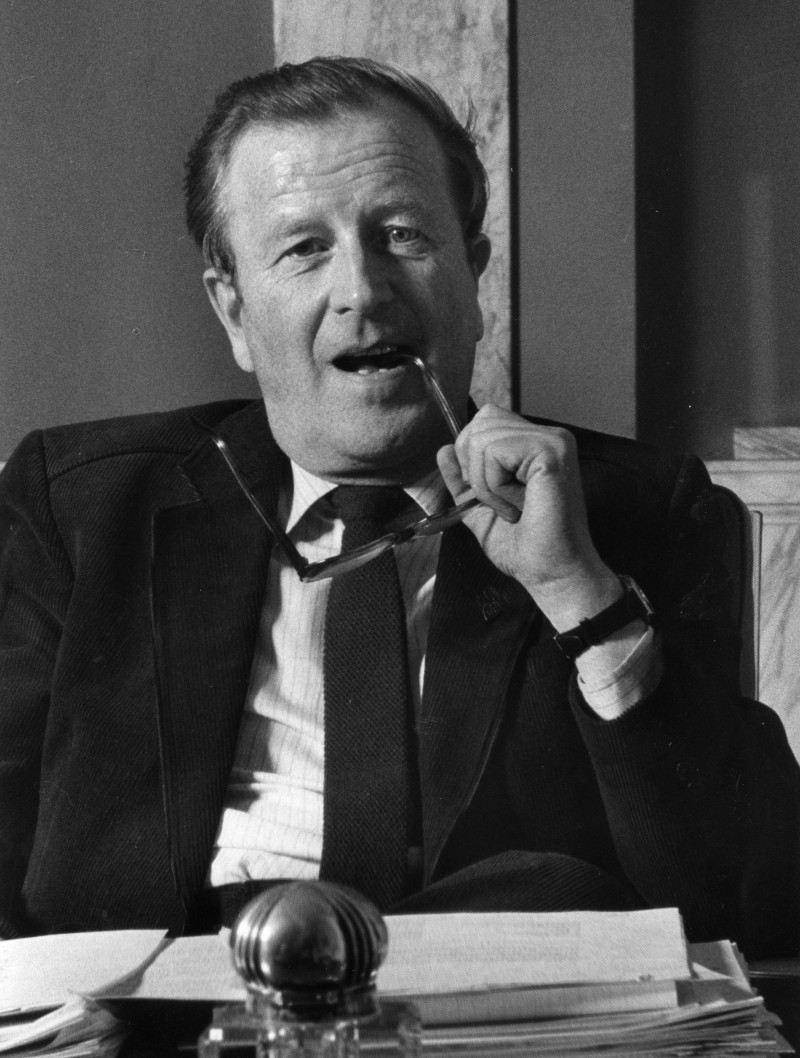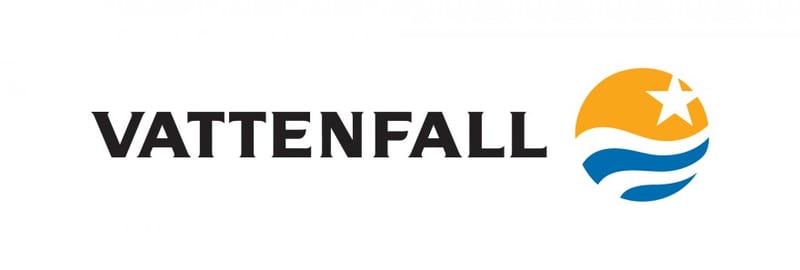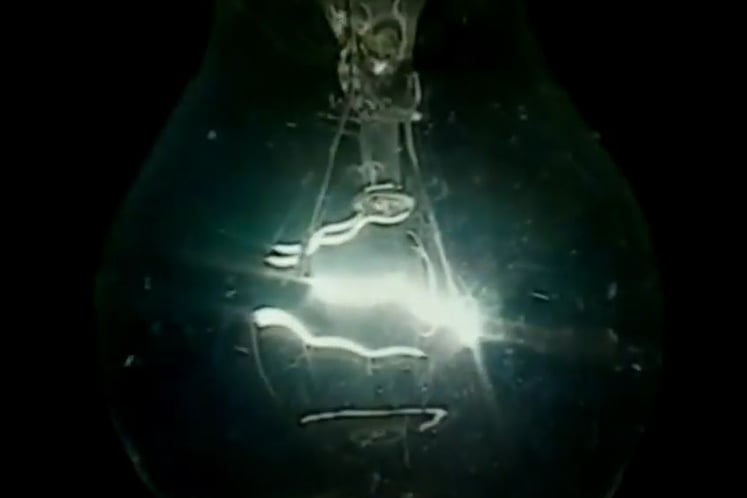Incorporation in the wake of financial crisis
The issue of incorporation of Vattenfall was far from new when it appeared on the political agenda in 1990. Vattenfall and state commissions had been trying to convince its owners of the benefits since the 1920s. But it took a national economic crisis for the idea to become reality.

Stock certificate for the electricity distribution company Björkö-Arholma, the company that changed its name and became Vattenfall AB.Year: 1937 | Place: - | Creator: Okänd | ID: VF001053
Vattenfall had been run as a public enterprise since it was founded in 1909. The board mainly came from the business community. Within Swedish state administration, this form of governance was something new.
However, the organisational form had several problems. Vattenfall's first Director General Vilhelm Hansen highlighted the difficulties of competitive salaries for officials, lengthy processes for every small investment matter and cumbersome and duplicated audits. As early as 1930, therefore, Besparingsutredningen (the Savings Commission), keenly supported by Vattenfall itself, proposed it be incorporated. But the government never examined the issue.

Carl-Erik Nyquist, Director general of Vattenfall 1985–2000. Year: 1988 | Place: - | Creator: Bengt Johansson | ID: VF000169
Almost 25 years later, in 1953, the 'Statliga företagsformer' (State Corporate Forms) government commission was set up. This identified that Vattenfall's biggest problem was inertia with regard to organisational changes and difficulties in setting salaries for senior staff. The right of access principle (offentlighetsprincipen) also meant that competitors and suppliers were given access to information that a company would not have to disclose. In 1957, therefore, the commission proposed that Vattenfall be incorporated. However, a number of interested parties were negative. The government therefore chose not to implement the proposal once more.

Börje Andersson, Chairman of the Vattenfall board 1985-2000, known as 'Red Börje'. Year: - | Place: - | Creator: Okänd | ID: VF000170
In 1967, Vattenfall itself brought up the question of incorporation with its owner. Vattenfall felt that faster decision-making channels were needed to facilitate cooperation with other players in the expansion of large-scale facilities, i.e. nuclear power plants. It was also necessary to deal with the increasing influence of municipalities on electricity distribution. In other words, Vattenfall needed to be able to act more quickly in order to enable the 'Swedish system' of private, municipal and state electricity supply to develop. However, yet again this proposal did not lead to any concrete change.
Crisis in state finances

Ingvar Carlsson, Prime Minister of Sweden 1986-1991 and 1994-1996. Year: - | Place: - | Creator: Frankie Fouganthin | ID: VF000171
In spring 1990 Vattenfall Director General Carl-Erik Nyquist and chairman of the board Börje Andersson, known as 'Röde Börje' ('Red Börje'), contacted then Swedish Prime Minister, Social Democrat Ingvar Carlsson. Nyquist and Andersson once more proposed incorporation. During the autumn Sweden was hit by an acute financial and currency crisis. And on 26 October 1990, the Social Democratic government presented a comprehensive package of measures. Almost hidden away was a proposal to convert Vattenfall from a state enterprise into a state-owned limited company. The reason: to increase efficiency in energy supply by enabling Vattenfall to act on the same terms as its competitors.
Privatisation discussions
The centre-right parties, however, wished to go one step further. Following the change of government in 1991, the centre right-controlled Ministry of Industry wanted to investigate the possibilities for privatising Vattenfall. A working group, 'Projekt Blå' (Project Blue), with representatives from Vattenfall and the ministry, was set up. In its final report, the group stated it wanted to broaden ownership and felt that at least 10 per cent of the shares should be sold to Swedish institutions.

Vattenfall logotype 1992–2018. Year: 1992 | ID: VF100000
Intensive work on preparing for the privatisation of Vattenfall commenced. But when the sales prospectus was ready, the work stopped. The Swedish Centre Party, which was part of the centre-right coalition government, opposed the plans, and Vattenfall was never privatised.
Video player requires marketing cookies.
To view this content please click here to allow marketing cookies.
Vattenfall becomes a limited liability company (in Swedish)




